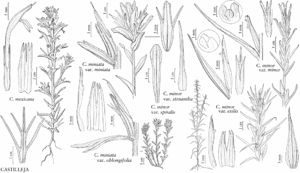Difference between revisions of "Castilleja mexicana"
Proc. Amer. Acad. Arts 21: 404. 1886. (as Castilleia)
FNA>Volume Importer |
imported>Volume Importer |
||
| (6 intermediate revisions by 2 users not shown) | |||
| Line 6: | Line 6: | ||
|place=21: 404. 1886 | |place=21: 404. 1886 | ||
|year=1886 | |year=1886 | ||
| + | |other_info_on_pub=(as Castilleia) | ||
}} | }} | ||
|common_names=Mexican paintbrush | |common_names=Mexican paintbrush | ||
|special_status={{Treatment/ID/Special_status | |special_status={{Treatment/ID/Special_status | ||
|code=F | |code=F | ||
| − | |label= | + | |label=Illustrated |
}} | }} | ||
| − | |basionyms={{Treatment/ID/ | + | |basionyms={{Treatment/ID/Basionym |
|name=Orthocarpus mexicanus | |name=Orthocarpus mexicanus | ||
|authority=Hemsley | |authority=Hemsley | ||
| + | |rank=species | ||
| + | |publication_title=Biol. Cent.-Amer., Bot. | ||
| + | |publication_place=2: 463, plate 63A, figs. 1–6. 1882 | ||
}} | }} | ||
|synonyms={{Treatment/ID/Synonym | |synonyms={{Treatment/ID/Synonym | ||
|name=Castilleja tortifolia | |name=Castilleja tortifolia | ||
|authority=Pennell | |authority=Pennell | ||
| + | |rank=species | ||
}} | }} | ||
|hierarchy=Orobanchaceae;Castilleja;Castilleja mexicana | |hierarchy=Orobanchaceae;Castilleja;Castilleja mexicana | ||
| Line 34: | Line 39: | ||
|elevation=1200–2100 m. | |elevation=1200–2100 m. | ||
|distribution=Tex.;Mexico (Aguascalientes;Chihuahua;Coahuila;Durango;Nuevo León;San Luis Potosí;Tamaulipas;Zacatecas). | |distribution=Tex.;Mexico (Aguascalientes;Chihuahua;Coahuila;Durango;Nuevo León;San Luis Potosí;Tamaulipas;Zacatecas). | ||
| − | |discussion=<p>Castilleja mexicana occurs in the northern third of Mexico and reaches the flora area only in southwestern Texas. Its conspicuous corollas can be either yellow or, less commonly, white. In both cases, the flowers turn soft pink-purple with age. Texas populations of this species are yellow flowered, and the white-flowered morph appears to occur only in northeastern Mexico. There is some indication of additional morphological differences between these color morphs that may justify varietal segregation. Castilleja mexicana is sometimes confused with the closely related C. sessiliflora, due to their conspicuous, distally curved, usually strongly exserted corollas, but the two species remain distinct.</p> | + | |discussion=<p><i>Castilleja mexicana</i> occurs in the northern third of Mexico and reaches the flora area only in southwestern Texas. Its conspicuous corollas can be either yellow or, less commonly, white. In both cases, the flowers turn soft pink-purple with age. Texas populations of this species are yellow flowered, and the white-flowered morph appears to occur only in northeastern Mexico. There is some indication of additional morphological differences between these color morphs that may justify varietal segregation. <i>Castilleja mexicana</i> is sometimes confused with the closely related <i>C. sessiliflora</i>, due to their conspicuous, distally curved, usually strongly exserted corollas, but the two species remain distinct.</p> |
|tables= | |tables= | ||
|references= | |references= | ||
| Line 43: | Line 48: | ||
-->{{#Taxon: | -->{{#Taxon: | ||
name=Castilleja mexicana | name=Castilleja mexicana | ||
| − | |||
|authority=(Hemsley) A. Gray | |authority=(Hemsley) A. Gray | ||
|rank=species | |rank=species | ||
| Line 57: | Line 61: | ||
|publication title=Proc. Amer. Acad. Arts | |publication title=Proc. Amer. Acad. Arts | ||
|publication year=1886 | |publication year=1886 | ||
| − | |special status= | + | |special status=Illustrated |
| − | |source xml=https:// | + | |source xml=https://bitbucket.org/aafc-mbb/fna-data-curation/src/2e0870ddd59836b60bcf96646a41e87ea5a5943a/coarse_grained_fna_xml/V17/V17_1106.xml |
|genus=Castilleja | |genus=Castilleja | ||
|species=Castilleja mexicana | |species=Castilleja mexicana | ||
Latest revision as of 19:25, 5 November 2020
Herbs, annual or short-lived perennial, 0.6–3 dm; from a woody caudex; with a slender taproot. Stems solitary or few, erect to erect-ascending, sometimes slightly curved at base, branched at base or unbranched, hairs spreading, long, stiff to soft, mixed with shorter stipitate-glandular ones. Leaves brown or purplish, sometimes green, linear to narrowly oblong, 1–5 cm, not fleshy, margins wavy, mostly involute, to flat, 3–5-lobed, apex acute; lobes spreading, linear, apex acute to obtuse. Inflorescences 2–17 × 1.5–6.5 cm; bracts greenish throughout, narrowly lanceolate (ovate in outline), 3–5(–7)-lobed; lobes spreading, linear to narrowly oblong, long, arising from 1/3–2/3 blade length, wavy-margined, apex rounded or obtuse to acute. Calyces proximally brownish green, purplish, or green, lobes tipped with same color as bracts, 18–28 mm; abaxial and adaxial clefts 6–14 mm, 33–50% of calyx length, deeper than laterals, lateral 1.5–6 mm, 8–20% of calyx length; lobes lanceolate to narrowly triangular, abaxials wider than adaxials, apex acute. Corollas straight proximally, conspicuously decurved distally, 35–60 mm; tube 26–46 mm; abaxial lip, beak, and majority of tube exserted; beak yellow to yellowish green, sometimes purplish tipped or drying pinkish, 9–15 mm; abaxial lip light yellow to whitish, prominent, not inflated, 4–8 mm, 50–75% as long as beak; teeth spreading-ascending, yellowish, 3–6 mm. 2n = 24.
Phenology: Flowering Feb–Oct.
Habitat: Dry rocky slopes, grasslands, pinyon-juniper stands.
Elevation: 1200–2100 m.
Distribution
Tex., Mexico (Aguascalientes, Chihuahua, Coahuila, Durango, Nuevo León, San Luis Potosí, Tamaulipas, Zacatecas).
Discussion
Castilleja mexicana occurs in the northern third of Mexico and reaches the flora area only in southwestern Texas. Its conspicuous corollas can be either yellow or, less commonly, white. In both cases, the flowers turn soft pink-purple with age. Texas populations of this species are yellow flowered, and the white-flowered morph appears to occur only in northeastern Mexico. There is some indication of additional morphological differences between these color morphs that may justify varietal segregation. Castilleja mexicana is sometimes confused with the closely related C. sessiliflora, due to their conspicuous, distally curved, usually strongly exserted corollas, but the two species remain distinct.
Selected References
None.
